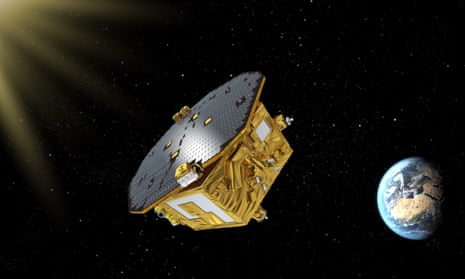This Thursday at 04:15 GMT, the European Space Agency (ESA) will launch the LISA Pathfinder spacecraft from Kourou, French Guiana. The choice of date is no accident. December 2nd is the 100th anniversary of Albert Einstein’s general theory of relativity, the best theory we have of gravity.
LISA Pathfinder is a pioneering mission designed to test new technology that will allow us to use Einstein’s theory to study the universe in more detail than ever before. If all goes well, astronomers will eventually find themselves with the equivalent of a new sense, like adding sound to vision.
Until now, most of the knowledge we have about the universe comes from seeing light or its equivalent, such as radio waves or ultraviolet radiation. To “listen” to the universe will mean detecting minuscule ripples in space.
Called gravitational waves, they were predicted by Albert Einstein to be given out when celestial objects change their speed or direction of travel. They will allow unprecedented studies of exploding stars and colliding black holes.
A passing gravitational wave will cause space to stretch and then shrink but the size of this distortion is much smaller than the width of an atom. To measure them requires something very special.
“LISA Pathfinder is the most perfect fundamental physics laboratory ever put into space,” says Paul McNamara, the mission’s project scientist. Approved by the ESA Science Programme Committee in 2000, it is the latest in a line of gravitational experiments that date back to the late 18th century. Each one has pushed the technological limits of the day.
In 1797, Henry Cavendish built a wooden shed on Clapham Common. Inside it, he put a crate. And inside that was a precise set of scales known as a torsion balance. The double wooden enclosure stopped air currents, which would have disturbed the apparatus and ruined the measurement.
Peering through tiny holes cut into the wood, Cavendish measured the tiny movement of suspended lead spheres on the balance. The movement was caused by the subtle pull of gravity between the spheres and he used it to calculate the density of the Earth. Eventually this measurement was also shown to yield the strength of gravity throughout the universe.
LISA Pathfinder is the modern equivalent of Cavendish’s shed. It must shield two metal cubes, known as test masses, from all external forces. The metal cubes are made of a gold and platinum alloy. They weigh 1.96 kg and are situated about 40 centimetres apart. They will be clamped for launch but once in orbit, they will be released to float unchecked in two cavities.
Using a system of lasers built by the University of Glasgow, the spacecraft will look for movements between them down to a trillionth of a metre. These readings will be used to manoeuvre the spacecraft to a few billionths of a metre, ensuring that the floating cubes do not hit the walls of their cavities.
“The key feature about LISA Pathfinder is the precision with which it can sense and control its movement,” says Ralph Cordy of Airbus Defence and Space in Stevenage, who built the spacecraft.
To achieve the unprecedented accuracy, Airbus engineers had to keep meticulous records of every single component so that the spacecraft balanced. Just moving a copper wire a few millimetres to one side could throw it out of equilibrium. If they have done their job correctly, LISA Pathfinder will generate an internal gravitational force of just one-tenth of a billionth of Earth’s gravity. But only by sending LISA Pathfinder into a space, where the test masses can float freely, can the success of the engineering be tested. There is a lot riding on it.
LISA Pathfinder itself will not be able to detect gravitational waves. But if all checks out it will pave the way for a mission called the Laser Interferometer Space Antenna (LISA). This mission was originally designed to be a collaboration between ESA and Nasa, and would have consisted of three identical spacecraft flying 5 million kilometres apart, communicating with each other via laser beam.
Nasa dropped out of the venture after the credit crunch, placing the whole thing in jeopardy. In 2011, ESA announced that it would pursue ways of building the mission on its own. Launch is now pencilled in for 2034.
Other missions are already being built that use LISA Pathfinder technology. The US-German Gravity Recovery and Climate Experiment Follow-on (GRACE-FO) mission will continually measure Earth’s changing gravity to track the movement of water around and within our planet. This will aid climate change studies.
LISA Pathfinder will also pave the way for ultra-precise tests of gravity. For all of its successes, Einstein’s relativity cannot explain what happens at the centre of a black hole. This is a weakness of the theory and clearly shows that a better one, termed quantum gravity, is waiting to be found.
Fledgling theories of quantum gravity all predict minuscule variations from relativity’s predictions. So, physicists are eager for increasingly precise equipment to look for these variations. Whether they get them rests on what happens with LISA Pathfinder.
Giuseppe Racca, the project manager of the mission at ESA from its inception to 2012, will be at the launch. “It is a mission that is very close to my heart. It is unlike anything else. Every day we were discovering new things about how to build it. To think of it all now on top of the spacecraft ready for launch is a fantastic thing.”
Einstein would have been equally excited.
This article was edited on Wednesday 2 December to correct the day of launch.

Comments (…)
Sign in or create your Guardian account to join the discussion